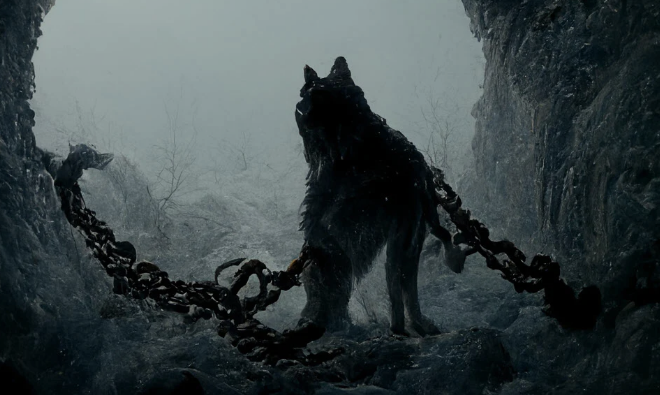Unraveling the Myth of Fenrir: The Formidable Wolf in Norse Mythology

The enigmatic tapestry of Norse mythology is interwoven with legendary tales, gods, and creatures. Amongst these characters, Fenrir stands out as one of the most fascinating yet formidable figures. Through this article, we will delve into understanding who Fenrir is, what he represents, and why he plays such a pivotal role in the tales of old.
Also Read:- Norse Runes and Viking Runes: A Ultimate Complete Guide
What is Fenrir the god of?
Contrary to common misconception, Fenrir isn’t a god. Instead, he’s a legendary giant wolf, born from the union of the trickster god Loki and the giantess Angrboda. While many associate wolves with different attributes across diverse cultures, in Norse mythology, Fenrir embodies chaos, destruction, and an overwhelming force. His very existence posed a threat to the gods of Asgard.
The Gripping Tale of Fenrir
To comprehend the essence of Fenrir, it’s crucial to unravel what is the story of Fenrir about?. Fenrir’s tale is one of prophecy, betrayal, and inevitable destiny.
From the moment of his birth, the gods of Asgard were wary of Fenrir due to a prophecy which foretold that this wolf would play a significant role in Ragnarok, the end of the world. The gods decided to raise Fenrir among themselves, hoping to keep him under control. Tyr, the god of war, was one of the few who dared to feed and care for the beast.
However, as Fenrir grew, so did his strength and the gods’ fear of him. Determined to bind him, they attempted on multiple occasions using various chains, but Fenrir broke free every time, showcasing his immense power.
In a final desperate bid, the gods commissioned the dwarves to create a magical ribbon called Gleipnir. Deceptively thin and light, it was made from six impossible things, including the sound of a cat’s footfall and the beard of a woman. When the gods proposed a challenge to Fenrir to test his strength against this seemingly frail ribbon, the wolf grew suspicious. He agreed on one condition: one of the gods must place their hand in his mouth as a sign of good faith. Tyr, showing unparalleled bravery, volunteered. As the gods successfully bound Fenrir with Gleipnir, he realized the deceit and in his rage, bit off Tyr’s hand.
Thus, Fenrir remained bound until the day of Ragnarok, when he would break free and seek his revenge.
Why is Odin afraid of Fenrir?
The prophecy that surrounded Fenrir’s existence is the root cause of the gods’ unease, especially Odin’s. It was foretold that during Ragnarok, Fenrir would kill Odin, swallowing him whole. This grim fate awaiting the Allfather, the chief of the gods, was a major reason for his trepidation. This prediction was the driving force behind the gods’ attempts to control and eventually bind Fenrir.
The Unmatched Powers of Fenrir
Answering the question of what are Fenrir’s powers? requires acknowledgment of his sheer might and significance in the Norse tales. Fenrir’s strength was unparalleled, breaking every chain the gods used in attempts to bind him. His size, too, was monumental, with legends suggesting that during Ragnarok, his jaws would stretch from the earth to the sky. Additionally, the power of prophecy — his destined role in the cataclysmic events of Ragnarok — grants him a certain inevitability and importance in the myths.
In Conclusion
Fenrir’s narrative is more than just a tale of a monstrous wolf. It represents the inescapability of destiny, the fears of the gods, and the complexities of deceit and bravery. Through the tale of Fenrir, Norse mythology imparts lessons on facing one’s fears and the often unavoidable nature of prophecy. In understanding Fenrir, we gain deeper insight into the rich and intricate world of Norse tales and the values, beliefs, and concerns of the ancient people who revered them.
FAQs about Fenrir in Norse Mythology
- Is Fenrir a god or a creature?
Fenrir is not a god; he is a legendary giant wolf in Norse mythology, a creature born from the union of Loki and the giantess Angrboda. - What does Fenrir symbolize in Norse mythology?
Fenrir often symbolizes chaos, destruction, and overwhelming force. His existence and eventual role in Ragnarok highlight the themes of inevitable destiny and prophecy in the Norse tales. - Why was Fenrir chained up by the gods?
Due to a prophecy that foretold Fenrir would bring about destruction during Ragnarok, including the death of Odin, the gods sought to bind him to prevent these events. - How was Fenrir finally bound?
The gods used a magical ribbon called Gleipnir, crafted by dwarves from six impossible things, to bind Fenrir. It appeared weak but was incredibly strong and unbreakable. - Did Fenrir have siblings?
Yes, Fenrir had two siblings: the serpent Jormungandr and the half-dead, half-living Hel who presided over the realm of the dead. - What role does Fenrir play in Ragnarok?
During Ragnarok, Fenrir breaks free from his bindings. He then goes on to fulfill the prophecy by swallowing Odin whole. He’s eventually slain by Odin’s son, Vidar.










